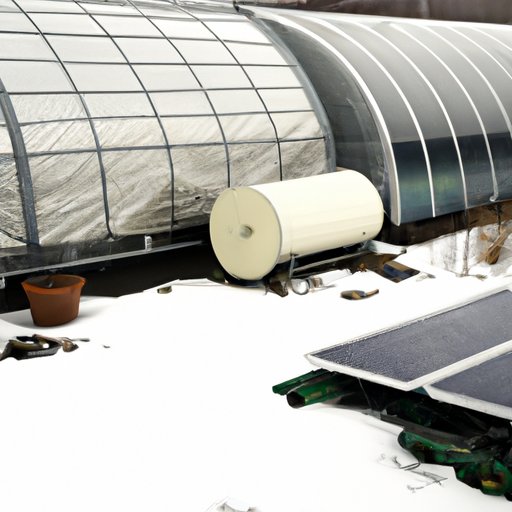
Introduction
If you are a greenhouse owner or enthusiast, you know that heating a greenhouse in winter can be a challenge, particularly if you are trying to keep your expenses low. Luckily, there are several options for heating your greenhouse for free, or at least reducing your heating costs significantly. This article will explore those methods, so you can stay warm and cozy inside your greenhouse, without spending a fortune on heating bills.
Passive Solar Heating Methods
One of the most straightforward methods for heating a greenhouse in winter for free is by using passive solar heating. This method involves utilizing sunlight to absorb and retain heat. Passive solar heating systems work by collecting sunlight during the day and storing that heat in thermal mass, which slowly releases the heat throughout the night. To maximize sunlight, it is essential to place the greenhouse in an area that receives ample sunlight, particularly during the winter months.
To maximize the effectiveness of passive solar heating, it is essential to have sufficient thermal mass in your greenhouse. Thermal mass materials, such as water, stone, and concrete absorb heat and retain it, thereby releasing it slowly during the night when the temperatures are cooler. Additionally, proper insulation is crucial to prevent heat loss. Insulation should be placed on the north-facing wall, as it is the wall that loses the most heat.
Benefits of using passive solar heating include cost savings, energy efficiency, and the reduction of carbon footprint.
Composting
Composting is another effective method for heating a greenhouse in winter for free. Composting is a natural process that generates heat as organic matter decomposes. The heat generated by composting can be used to heat your greenhouse by bringing the compost inside the greenhouse. To turn the compost pile in your greenhouse, you need to mix the compost together by turning it with a pitchfork. This process will help to release the build-up of carbon dioxide and other gases and result in a more even compost pile.
Using composting as a heating method in your greenhouse offers multiple benefits, including cost savings, using organic matter, improving soil fertility, and reducing greenhouse gas emissions.
Water Barrels
Water barrels or containers can also be used as a cost-effective method for heating a greenhouse in winter. Water has a high thermal mass, meaning it can store and release heat efficiently. By filling barrels with water and placing them inside the greenhouse, the water can store heat during the day and release it slowly during the night, when temperatures are cooler.
Water containers should be placed in sunny areas within the greenhouse for maximum sunlight exposure. It is also possible to paint the barrels black to enhance heat absorption. Along with keeping your greenhouse warm, water barrels are also an excellent addition to your greenhouse, as they can function as supplementary water storage containers.
By using water barrels in your greenhouse, you can reap the benefits of lower energy costs, energy efficiency, and a greener environment.
Windbreaks
Windbreaks are barriers that can be placed around a greenhouse to reduce heat loss. Windbreaks can be made of various materials, including wood, straw bales, or flexible plastics. Windbreaks are used to block wind and consequently reduce heat loss.
It is crucial to install windbreaks on the side of the greenhouse that faces the strong prevailing wind. The windbreak should also be tall enough to block the wind effectively. However, care must be taken to ensure that the windbreaks do not shade the greenhouse and that the greenhouse still receives enough sunlight.
Windbreaks reduce heating costs and energy usage, protect plants from wind damage, and increase the lifespan of the greenhouse.
Insulation
Insulation is essential for retaining heat in the greenhouse. Insulation works by trapping air within its fibers and creating a barrier that prevents heat from escaping. Insulating material can be placed on the walls, roof, and floor of the greenhouse. Common materials used for insulation include fiberglass, cellulose, and foam board.
Insulation should be installed properly to prevent air leaks. Any gaps in the insulation can lead to heat loss; thus, it is crucial to pay close attention to the insulation installation process. Furthermore, insulation should also be changed out periodically to prevent deterioration and to ensure that it remains effective.
By insulating your greenhouse, you can significantly reduce heating costs, energy usage, and greenhouse gas emissions.
Using Solar Panels
Solar panels can be a smart way to heat your greenhouse while also reducing energy bills. Solar panels generate electricity by converting sunlight into energy. These panels can power heating systems that can warm the greenhouse during the winter months.
Solar-powered heating systems operate on a thermostat, which will turn on when temperatures decrease, and turn off when temperatures rise. These systems utilize the energy generated by the solar panels to warm the greenhouse, making it an eco-friendly and cost-effective heating option.
Using solar panels in your greenhouse can result in energy cost savings, reduced carbon footprint, and increase the lifespan of the greenhouse.
Conclusion
Heating a greenhouse in winter for free is possible, with the proper implementation of passive solar heating, composting, water barrels, windbreaks, insulation, and solar panels. By utilizing these methods, you can reduce energy expenses, lower carbon footprint, and increase the lifespan of your greenhouse.
As winter approaches, these methods are efficient and easy to use. Start with passive solar heating and use water barrels, composting for heating. Windbreaks can keep your plants safer whereas insulation and solar panels are great add-ons for maximum heat retention.




